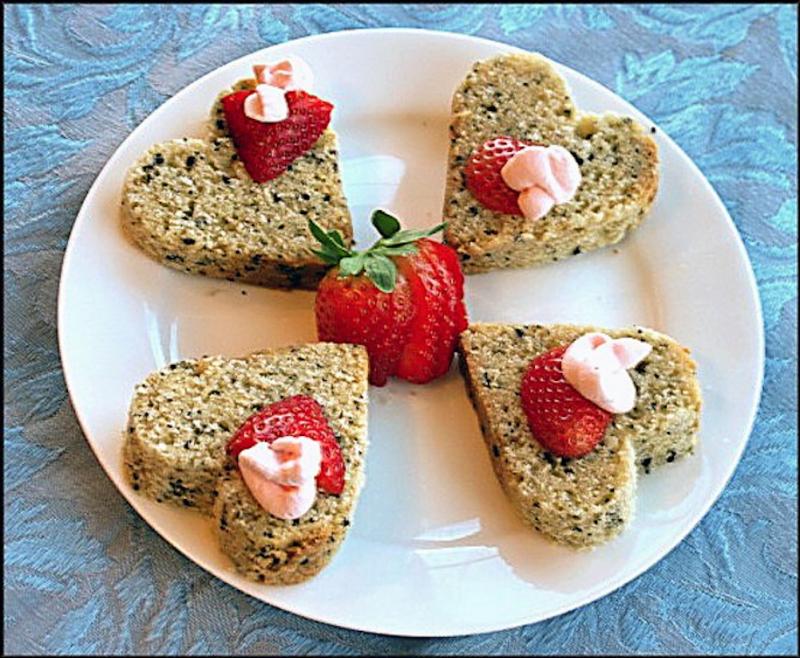Pound cake makes a simple yet elegant sweet treat
With Valentine’s Day just around the corner, I thought it might be helpful to give you some ideas for your holiday dessert menu. While many local restaurants are advertising specials during the weekend before, you may encounter a conflict with plans to watch the Olympics or the Super Bowl. And, if you want to go out on Feb. 14, make sure your destination is open on Mondays.
Or, you can keep it simple and make a romantic dinner at home, perhaps a beautiful piece of grilled fish or beef tenderloin with a side of twice-baked potatoes and sautéed green beans with slivered almonds. Of course, you’ll want a glass of champagne to toast your sweetheart, along with a delectable dessert like the lemon poppyseed pound cake in the photo.
Pound cake has a long and curious history, beginning with its name. The earliest recipe appeared in “The Art of Cookery” by Hannah Glasse, published in England in 1747. The name refers to the recipe itself, which calls for one pound each of butter, eggs, sugar and flour. The somewhat dry, dense cake became popular because of the simplicity of the recipe and the generous size of the resulting cake. Glasse’s original recipe did not include familiar leavening agents such as baking powder or baking soda, relying instead on the air whipped into the batter.
The recipe evolved slightly during the next 50 years. By the time the first cookbook published in this country appeared in 1796, author Amelia Simmons featured two versions of pound cake in “American Cookery.” In the first recipe, she adds rose water and “spices to your taste.” Her second recipe instructed the baker to beat the egg whites and yolks separately, adding rose water and brandy to the batter.
Over time, the cake became sweeter, moister, lighter and more flavorful as recipes were continually tweaked. In the 1900s, artificial leavening agents were added to reduce the cake’s density. Other variations included the addition of specific flavors, such as vanilla or almond extract, lemon juice and lemon zest. Often, you will see recipes where butter is replaced by vegetable oil, or sour cream is added to increase moisture. Despite the alterations, the result is still called “pound cake.”
Pound cake and its cousins are well known around the world. The French call theirs “quarte quarts” for the four quarters in a pound. In the Caribbean, they add rum and mashed bananas. Venezuelans and Colombians use the term “ponque,” a Spanish phonetic approximation of the name, for their wine-drenched, sugar-coated cake.
To give you a few variations to try, I’ve included the three most popular types of pound cake: traditional, lemon poppyseed and sour cream. You can simply slice the cake, or use a cookie cutter to create heart-shaped slices. Sliced strawberries work well as a garnish, and pink-tinted whipped cream adds colorful notes. Happy Valentine’s Day to you and yours!
Lemon Poppyseed Pound Cake
3 eggs
3 T milk
1 1/2 t vanilla
1 1/2 C flour
3/4 C sugar
3/4 t baking powder
1/4 t salt
1 T lemon zest
3 T poppyseeds
13 T butter
Have all your ingredients at room temperature. Preheat oven to 350 F. Line the bottom of a loaf pan with parchment paper and coat the interior with nonstick cooking spray. In a small bowl, whisk together eggs, milk and vanilla; set aside. In a large bowl, sift together flour, sugar, baking powder and salt. Add lemon zest and poppyseeds; toss with a spatula to combine. Add the butter and half the egg mixture; beat on low with a mixer until moistened, then increase speed to high and beat for 2 minutes. Scrape down the sides of the bowl and add the remaining egg mixture; beat to combine. Pour batter into prepared pan and bake until a cake tester comes out clean, about one hour.
Cool the pan on a wire rack for about 10 minutes, then remove the cake from the pan and cool completely.
Sour Cream Pound Cake
1 C sour cream
2 t vanilla
6 eggs, separated
1/4 t cream of tartar
1/2 C sugar
3 C flour
1/4 t baking soda
1/4 t salt
1 C butter
2 C sugar
Preheat oven to 325 F. Coat the inside of a tube pan with nonstick cooking spray. In a small bowl, whisk together sour cream and vanilla; set aside. Collect the egg yolks in a small bowl and the whites in a medium mixing bowl. Add cream of tartar and sugar to the whites and whip until peaks are stiff but not dry; set aside. Sift together flour, baking soda and salt; set aside. In a large mixing bowl, beat the butter until creamy. Add the sugar gradually and beat until light and fluffy, about 3 or 4 minutes. Add the yolks one at a time, beating continuously on low. Add the dry ingredients in 3 parts, alternating with the sour cream. Fold in the beaten egg whites. Pour the batter into the prepared pan and bake until a tester comes out clean, about 1 hour and 15 minutes. Cool the pan on a rack for 10 minutes, then remove the cake from the pan and allow to cool completely.
Traditional Pound Cake*
1 C butter
1 C sugar
1 t vanilla
4 eggs
1 2/3 C flour
1/4 t salt
Preheat oven to 325 F. Coat the inside of a loaf pan with nonstick cooking spray. Cream together butter, sugar and vanilla until very light and fluffy, about 7 to 9 minutes. Add eggs one at a time, beating well after each addition. Add salt, then flour a little at a time, beating just until combined after each addition. Pour batter into prepared pan and bake until a cake tester comes out clean, about 65 minutes. Cool pan for 10 minutes on a rack, then remove cake from the pan and cool completely before slicing. *Note: with no additional leavening, it is essential to beat the egg and sugar mixture long enough to incorporate sufficient air into the batter.
























































